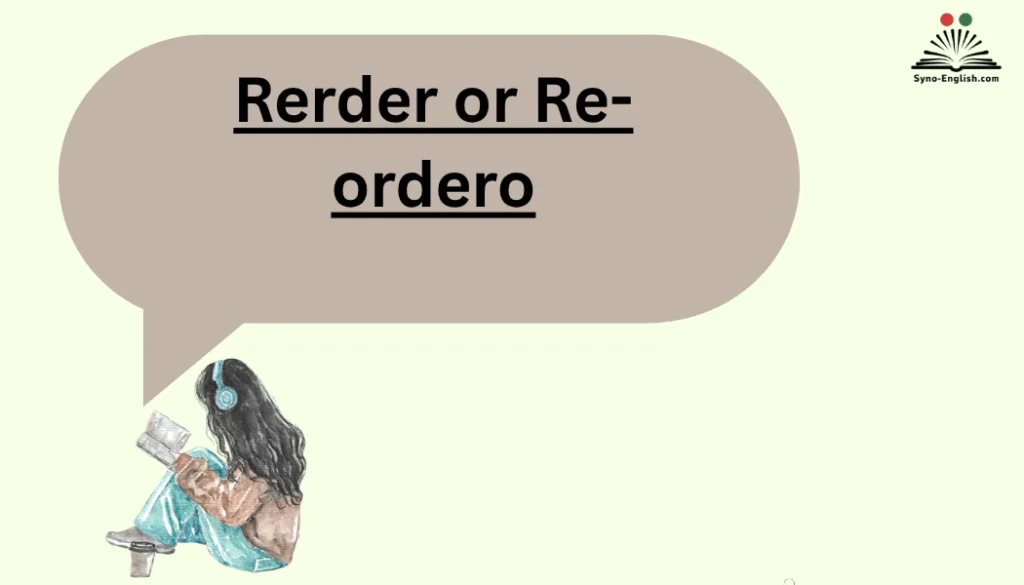When I first began editing professionally, hyphenation quickly drew my attention. It looked like a tiny detail, but it often led to confusion in editorial work. I’ve seen long debates among writers, editors, and students about the meaning of a sentence when you write Reorder or Re-order — a phrase that often stirs stylistic choices. The small dash in between can feel like solving a puzzle, even for professionals working alone.
This choice isn’t always easy—the answer is rarely cut and dry—but that’s what makes it fascinating to explore.From my experience, I’ve found that strong rules and trusted references help in making a confident decision. A well-crafted guide that unpacks how American English explores style guides and how each treat the term differently gives real clarity.
Many US editors prefer “reorder,” while some in the UK compares it to traditional practices where “re-order” was once common. These differences shows how language evolves, adapting to modern trends and shaping our written forms across cultures
The Core Rule: When to Hyphenate the Prefix “Re-”
In American English, the prefix “re-” usually attaches directly to the base word without a hyphen. That means the default spelling is reorder.
However, the hyphen serves a critical role when attaching “re-” could create confusion or unintended meaning. Consider these examples:
- resign → means to quit a job
- re-sign → means to sign again
Another case:
- recover → means to get better
- re-cover → means to cover again
These pairs highlight why the hyphen exists — it clears up ambiguity. Without it, readers could misunderstand the intended meaning.
So the golden rule is simple:
➡️ Use re- + word (no hyphen) unless a hyphen is needed to prevent confusion.
Breaking Down the Prefix “Re-” in American English
The prefix “re-” has been part of English since it arrived through Latin and Old French. It typically means again or back. Over time, English writers moved toward dropping the hyphen, especially in American usage.
Today, words like reopen, redo, rebuild, and rethink are almost always written closed (without a hyphen). Hyphenated forms like re-open look old-fashioned to most readers.
The shift reflects a larger trend: modern American English favors simplification and closed compounds. Hyphens are disappearing unless they serve a practical purpose.
Still, “re-” presents tricky cases when the base word begins with “e.” For example:
- reenter (accepted US spelling, though some still prefer re-enter)
- reengage (again, standard in US usage, though re-engage may appear)
In these cases, dictionaries differ, which makes knowing your audience and style guide essential.
Role of Authoritative Style Guides
One reason confusion persists is that style guides don’t always agree. Journalists, academics, and publishers often follow different rules. Let’s break it down.
AP Stylebook
The Associated Press (AP) Stylebook is the go-to for journalists and many corporate communicators. AP leans heavily toward closed compounds — meaning no hyphen.
- AP says: “reopen” not “re-open.”
- Hyphens stay only when needed for clarity: re-sign vs resign.
- Hyphen before proper nouns: re-Sovietize.
So if you’re writing for a newsroom or media outlet, stick with reorder unless clarity demands otherwise.
Chicago Manual of Style (CMOS)
The Chicago Manual of Style (CMOS), widely used in publishing and academia, also favors closed forms. But it’s a little more flexible than AP.
- CMOS notes that “re-” words are almost always closed.
- Use a hyphen only to avoid misreading or when dictionaries prefer it.
Example: CMOS lists re-create (to create again) vs. recreate (to enjoy leisure).
Merriam-Webster & Oxford Dictionaries
Dictionaries influence real-world spelling more than stylebooks.
- Merriam-Webster (American dictionary) overwhelmingly lists closed forms: reorder, reopen, reenter.
- Oxford English Dictionary (OED) sometimes leans toward hyphenated or spaced forms in British usage: re-enter.
This divergence means American and British readers may expect different spellings — a point we’ll explore further below.
Practical Usage of “Reorder” vs. “Re-order”
Now let’s get specific:
- In modern American English, the standard spelling is reorder.
- Re-order might appear in older texts, legal documents, or for emphasis in typesetting, but it’s rare today.
- Search data confirms this trend. A quick comparison of Google Books shows “reorder” massively outpaces “re-order” since the mid-20th century.
Case Study: Digital Tools
- Microsoft Word flags re-order as incorrect and suggests reorder.
- Grammarly recommends reorder unless ambiguity requires re-order.
- Google Docs follows the same pattern.
The verdict is clear: if you’re writing for an American audience in 2025, use reorder.
Words That Break the Hyphen Rule
Some “re-” words keep the hyphen because without it, meaning changes drastically. Let’s see the most common examples:
| Hyphenated Form | Closed Form | Difference in Meaning |
| re-sign | resign | Sign again vs. quit |
| re-cover | recover | Cover again vs. heal |
| re-creation | recreation | Creating again vs. leisure |
| re-form | reform | Form again vs. improve/change |
| re-collect | recollect | Gather again vs. remember |
These pairs prove why writers must check context carefully. One misplaced hyphen can turn a contract negotiation into a resignation letter.
Common Mistakes Writers Make
Even skilled writers stumble when dealing with “re-.” Here are the most frequent errors:
- Over-hyphenation: Writing re-open, re-order, re-cover when modern usage prefers closed forms.
- Under-hyphenation: Skipping a necessary hyphen and creating unintended meanings (e.g., resign vs re-sign).
- Guessing: Relying on “what looks right” instead of checking a dictionary or style guide.
Quick Fix
- Default to closed form (reorder).
- Use a hyphen only if the closed form changes meaning.
- When in doubt, consult Merriam-Webster (for US) or Oxford (for UK).
American vs. British English Differences
American and British English share the same rules in principle, but British writers are more conservative with hyphenation.
- American English: favors closed compounds (reorder, reenter).
- British English: often keeps the hyphen (re-order, re-enter).
For example:
- US: reenter the building
- UK: re-enter the building
If you’re writing for a global audience, it’s best to check the target publication’s house style.
Hyphenation and Capitalization in Titles
Hyphens affect more than spelling — they influence title formatting.
- In AP Style, capitalize both parts of a hyphenated compound in title case: Re-Order Policy Updates.
- In Chicago, capitalize the first part and subsequent parts only if they are proper nouns: Re-order in Context.
When in doubt, consistency matters more than the rule itself.
Decision-Making Framework for Writers
Here’s a quick decision-making tool you can apply whenever you face the reorder vs re-order question.
Checklist for “Re-” Words
- Does the word exist in the dictionary without a hyphen? → Use that form.
- Does dropping the hyphen change the meaning? → Keep the hyphen.
- Am I writing for an audience that follows AP or CMOS? → Follow that style.
- Am I writing for Americans or Brits? → Adjust spelling accordingly.
Table of Examples
| Word | Preferred US Form | Preferred UK Form | Notes |
| reorder | reorder | re-order (less common) | Standard in US |
| reopen | reopen | re-open | Hyphen more common in UK |
| reenter | reenter | re-enter | US prefers closed |
| recreate | recreate | recreate | Hyphen only if meaning changes |
| resign/re-sign | resign / re-sign | resign / re-sign | Same rules apply |
Conclusion
The debate over Reorder or Re-order highlights how even small punctuation marks like a hyphen can shape the tone, meaning, and clarity of language. Writers, editors, and professionals often encounter this dilemma, discovering that the difference between these forms isn’t merely grammatical—it’s stylistic. In American English, “reorder” has become the preferred form, while “re-order” still finds relevance in older UK texts or formal writing. This subtle variation demonstrates how language evolves, adapting to usage patterns, cultural norms, and editorial preferences. Understanding this distinction builds confidence for anyone engaged in writing or editing.
In professional communication, maintaining consistency and following style guides strengthens credibility. Choosing between “reorder” and “re-order” is less about right or wrong and more about aligning with your audience and context. When used thoughtfully, such distinctions enhance readability and convey attention to detail. Every hyphen, dash, or word choice contributes to effective expression, bridging the gap between technical correctness and creative intent. Ultimately, this discussion reminds us that mastering these small elements defines professionalism in writing—balancing rule and flexibility in the art of communication.
FAQs
What is the main difference between “reorder” and “re-order”?
“Reorder” is the modern, preferred form in American English, while “re-order” is an older variant still used in some UK or formal contexts. The hyphen in “re-order” emphasizes repetition or clarification, but both convey the same meaning—to arrange again. Choosing one depends on the style guide or audience preference rather than strict grammatical necessity.
Why do style guides differ on “reorder” and “re-order”?
Different style guides reflect varying editorial traditions. American English often removes unnecessary hyphens, favoring “reorder,” while UK editors may keep “re-order” for clarity or historical style. Guides like APA and Chicago Manual of Style promote modern simplification, but others allow flexibility. Understanding which guide your publication follows ensures consistent and professional usage throughout your work.
Does using the wrong form affect meaning?
Not significantly—both “reorder” and “re-order” mean to arrange or organize something again. However, in nuanced writing, “re-order” may emphasize the act of doing something once more, while “reorder” implies a routine or system change. The distinction is stylistic, not semantic, so clarity and audience context should guide your choice rather than rigid grammar rules.
Which form is more common today?
The single-word form “reorder” is far more common in modern writing, particularly in American English publications, business writing, and online platforms. The hyphenated “re-order” appears mostly in UK English or older texts. Writers should adapt to the dominant form in their region or based on the style guide their organization or publication follows.
Can both forms be used in the same document?
It’s best to avoid mixing the two forms in a single document. Consistency matters in professional writing. Choose either “reorder” or “re-order” based on your style guide and stick with it throughout. This approach enhances readability and reflects attention to detail—key qualities that distinguish professional writing from casual communication or inconsistent editing.
How do editors decide which version to use?
Editors rely on style guides, context, and publication standards. For instance, US editors prefer “reorder,” while some UK editors may retain “re-order” for tradition. The decision also depends on readability—if a hyphen helps prevent confusion or awkwardness, it stays. Editorial judgment ensures that meaning remains clear while respecting linguistic consistency and modern language evolution.
Why does hyphenation cause confusion among writers?
Hyphenation can be confusing because rules often shift as language modernizes. What was once standard, like “re-order,” may now seem outdated. Writers struggle with deciding when the hyphen adds clarity or when it’s unnecessary. The solution lies in using reliable references and style guides to make confident, consistent decisions aligned with audience expectations and contemporary writing norms.
What role does audience play in choosing between “reorder” and “re-order”?
Audience matters greatly. For readers familiar with American English, “reorder” feels natural and modern. However, if writing for a UK or academic audience, “re-order” might appear more precise or traditional. Understanding who you’re writing for allows better stylistic choices that enhance communication while maintaining professionalism and cultural awareness in global writing contexts.
Do other words follow similar hyphenation rules?
Yes, many prefix-based words have evolved similarly. For example, “rewrite” replaced “re-write,” and “recover” replaced “re-cover” except when meaning changes. The trend is toward simplification—dropping unnecessary hyphens unless they prevent misreading. Learning these patterns helps writers adapt to modern usage while appreciating how small punctuation choices can still carry significant meaning.
How can writers gain confidence in using hyphens correctly?
Writers can build confidence by consulting trusted style guides, observing reputable publications, and practicing consistently. Reading professional work in American English and UK English helps identify patterns in hyphenation and modern usage. Over time, making these choices becomes instinctive, ensuring your writing is both clear and aligned with professional standards across contexts.

Emma Brooke is a passionate English educator, writer, and language enthusiast with over a decade of experience helping learners master the nuances of the English language. At SynoEnglish, she blends practical grammar advice with real-world communication tips to make English easier, clearer, and more enjoyable for readers of all levels.



